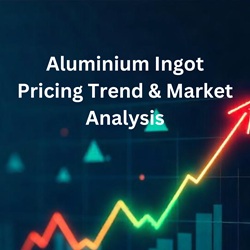
Aluminium Ingot Price Trends
Aluminium ingots, a key raw material in many manufacturing processes, have always been an essential commodity for industries worldwide. As we approach 2025, the global aluminium market is poised for several changes that could significantly affect the pricing of aluminium ingots. These price changes will be driven by factors such as increased demand from electric vehicle (EV) manufacturing, fluctuations in energy prices, geopolitical risks, and the ongoing efforts to reduce carbon footprints through recycling.
In this article, we will take a closer look at the key elements that will impact aluminium ingot prices in 2025, offering insights for manufacturers and businesses that depend on aluminium.
The Importance of Aluminium Ingots
Aluminium ingots are the raw material from which many products are made. They are formed through the process of smelting alumina, which itself is derived from bauxite. The resulting aluminium ingots are then used to create products such as automotive parts, packaging materials, and construction components. These ingots serve as the building blocks for many industries, and fluctuations in their price have far-reaching consequences.
The price of aluminium ingots is highly volatile, influenced by factors such as supply and demand dynamics, energy costs, and geopolitical events. As we approach 2025, several factors are expected to influence the price of these ingots.
Book a Demo for a real-time, data-driven insights: https://www.price-watch.ai/book-a-demo/
Factors Shaping Aluminium Ingot Prices in 2025
1. Growing Demand for Electric Vehicles
One of the biggest drivers of aluminium demand in 2025 will be the continued expansion of the electric vehicle (EV) market. Aluminium is increasingly used in electric vehicles due to its light weight, which helps improve fuel efficiency and range. As governments around the world continue to push for cleaner, more sustainable transportation options, the demand for EVs—and consequently, aluminium—will grow.
This rise in demand for aluminium from the automotive sector is expected to exert upward pressure on aluminium ingot prices. EV manufacturers, in particular, are expected to need significant amounts of aluminium to produce lighter and more efficient vehicles, further driving demand.
2. Energy Prices and Production Costs
Aluminium production is an energy-intensive process, with smelting being one of the most energy-consuming stages. As a result, fluctuations in energy prices are a key factor influencing aluminium ingot prices. Any increases in the price of electricity or natural gas will directly impact the cost of producing aluminium.
If energy prices rise in 2025, particularly due to shortages or geopolitical tensions in major energy-producing regions, aluminium ingot prices are likely to follow suit. Manufacturers will need to account for these price fluctuations in their budgeting and production planning to remain competitive.
3. Recycling and Sustainability Trends
As sustainability becomes an increasingly important consideration in manufacturing and consumer goods, the demand for recycled aluminium is expected to grow. Recycling aluminium requires far less energy than producing new aluminium from bauxite, making it an environmentally friendly and cost-effective alternative.
In 2025, businesses that rely on aluminium may increasingly turn to recycled aluminium as a way to mitigate rising costs. This shift toward recycling could help stabilize prices and reduce dependence on primary aluminium production, which is more susceptible to energy price fluctuations.
4. Geopolitical Risks and Trade Policies
Aluminium prices are also heavily influenced by geopolitical events and trade policies. Trade disputes, such as those between the U.S. and China, have historically resulted in tariffs and other trade barriers that disrupt global supply chains. Any trade restrictions or political instability in major aluminium-producing regions, such as bauxite-rich countries like Guinea and Australia, could result in higher aluminium prices.
In 2025, businesses will need to closely monitor geopolitical developments that may impact the aluminium supply chain. Trade restrictions or sanctions could lead to supply shortages, further driving up prices.
Forecast for Aluminium Ingot Prices in 2025
Based on current trends, it is likely that aluminium ingot prices will experience gradual increases in 2025. The rising demand for aluminium, particularly from the electric vehicle sector, coupled with potential disruptions in energy costs and supply chains, will drive prices higher. However, increased recycling efforts and technological advances in production processes could provide some stabilizing forces in the market.
Aluminium ingot prices in 2025 will be influenced by a variety of factors, including rising demand from the automotive sector, energy price fluctuations, advancements in recycling technologies, and geopolitical risks. As manufacturers and businesses prepare for these changes, it is essential to stay informed about market trends and develop strategies to manage rising costs. By understanding the forces at play in the aluminium market, businesses can navigate the challenges and opportunities ahead in the coming years.









